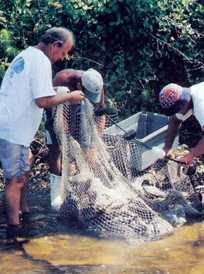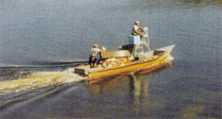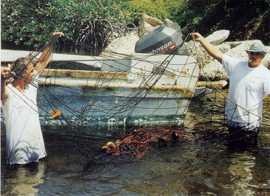The story below has been resolved, as
reported by Florida Sportsman Magazine, December 2000 issue. The
state ruled that nets with vertical ropes violate Florida's
prohibition on big nets.
Here's the latest in net scams by our friends that don't want
to work with rod and reel to make their money. It seems no matter
what laws that are passed, there will always be someone that
wants to skirt their way around the edges in order to make a
quick buck. This is one of the main reasons that you need to keep
your eyes open when you are on the water and report whatever
violation that you see.......................Capt. Charlie
Reprinted by permission from Florida
Sportsman Magazine Online.
Sportsman's Stand:
Strings and Scams May Break Our Bones...
A ton-taker never sleeps.
He's the fisherman who likes to catch his fish
by the ton and then sell them for profit.
He is determined, among other things, to come
up with any kind of method to somehow get around the state
constitutional amendment of 1995 that banned all gill nets and
big seine-type nets.
In essence, he opposes the whole purpose of
the voter-approved amendment (72 percent in favor), which was to
stop large-volume catches and thereby restore fish populations.
To an amazing extent, based on statewide
reports and data, the net ban has worked wonders.
Unfortunately, some of the ton-taker tricks also are working.
Now, it is up to state authorities whether the
intent of the amendment is to be implemented fully or left open
to clever new devices, word-splitting and questionable
interpretations of what seemed to be obvious to all.
Clearly, the Florida Fish and Wildlife
Conservation Commission has the power, and duty, to carry out the
amendment and plug any perceived loopholes created by the
ton-takers.
It's an unending job, but commissioners must
stand tall and firm in the face of profit-seeking that would once
again decimate the wild fish stocks as the ton-takers compete for
a public resource that they consider to be up for grabs.
Give an inch, lose a mile.
A new inch, not a word about which has been
publicized, involves "string nets" being operated by at
least five commercial fishermen in the St. Lucie River.
Stringscam is an unwelcome addition to attempted
amendment-beaters such as tarp nets, hoop-traps, entanglement
cast nets, toy boat ploys, black stealth gear and herding
devices.
An easy way to stop the ton-taking methods, it
should be said at the outset, would be for the state to simply
specify allowable gear and state by law how it may be deployed.
Anything else is illegal. Then enforce it. Done.
String nets employ black poly ropes hung
vertically in the water from a float-line of 300 feet or more in
circumference. Spliced into the center is a legally sized
500-square-foot seine net.
After being deployed in its huge circle, the
string section is slowly brought together. Targeted fish, notably
sheepshead, don't like to swim through the rope fence and find
themselves corralled into the legal seine net.
Hundreds of fish are caught as ton-taking
continues.
Commercial fishermen show the black
plastic ropes that hang vertically in the
water to funnel fish toward the legal
seine portion of the gear.
"Come right on over, boys," a string-net
operator yelled to us when we watched the gear in the St. Lucie.
"This is all perfectly legal. You can call the Marine
Patrol. It's an experiment and they said we could go ahead. It'll
probably be outlawed but we're just catching a few
sheepshead."
We watched the string gang take about 100
pounds of sheepshead and throw out a number of other fish,
including moonfish, catfish and sting ray. The sheepshead fetch
90 cents a pound.
The Marine Patrol, now called the Marine Law
Enforcement Bureau, confirmed that the string nets are being
allowed, pending a determination from Tallahassee.
Lt. Royce Hamilton in Jupiter said the problem
is that no one knows yet whether the lines of black poly ropes
would be considered a "net." And being connected to
each end of the legal seine raises further questions. "Next
you'll have to see whether horizontal ropes can be attached, and
then there's the idea out there to use webbing like in lawn
furniture or something else."
String operators in themselves seem to pose a
relatively small threat to the resource at this writing. But once
a form of gear is used widely it tends to spread across the state
and be almost impossible to eliminate (hence the net ban
campaign).
The answer would seem to be easy enough if the
state will put in writing that allowable gear must be used in
traditional ways and without attachments or any type of man-made
herding devices.
Meanwhile, besieged by commercial lobbying,
the FWC and a number of government employees have been slow to do
a comprehensive job while coping with individual issues such as
the still-proposed hoop-traps, tarps and toy boats, the latter
involving net vessels carrying tiny boats aboard to supposedly
qualify for having twice the number of seine nets.
A play boat for the kids? Nope, the tiny boat
aboard this net boat on the west coast is supposed to
justify using four seine nets at a time instead of two.
 |
On it goes.
Problems will persist as long as people in
power allow ton-taking by a few while general public fishing
operates under strict individual limits intended to protect
fragile inshore fish populations.
The same philosophy that has succeeded so well
in our management of deer, wild turkey, ducks, squirrels, bass
and countless other critters, as well as saltwater treasures such
as snook and redfish, must be fully extended to the marine scene.
It takes courage and determination.


